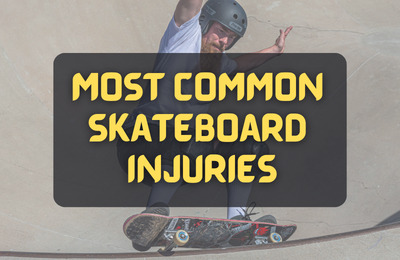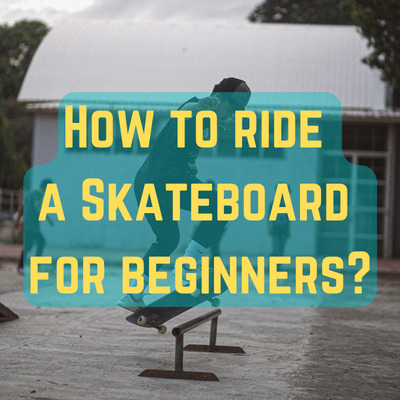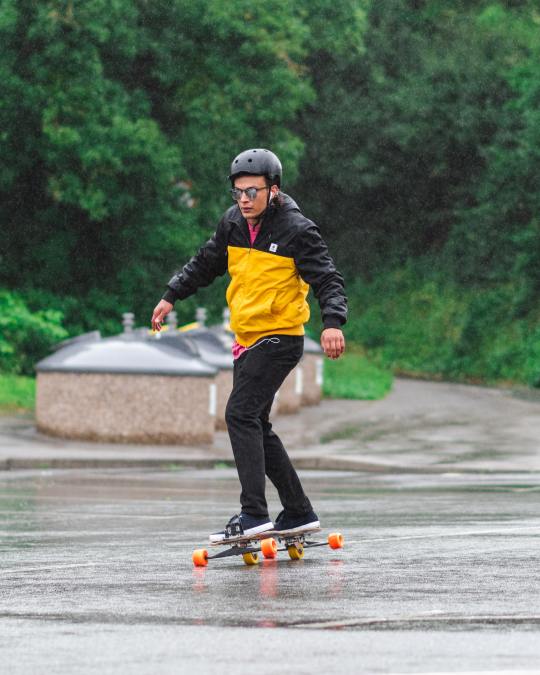Text
How To Push A Skateboard Without Falling?
Introduction:
How to push a skateboard without falling may seem like a simple task, but it's an important skill for beginners to master. Being able to push a skateboard smoothly and steadily is the foundation for all other skateboarding tricks and techniques. It allows you to build momentum and control your speed, and it also helps you to maintain balance and stability on the skateboard. In this article, we'll go over the steps you need to take to push a skateboard without falling, and offer tips and techniques to help you practice and improve your skills. Whether you're just starting or you're looking to improve your pushing technique, these tips will help you become a more confident and capable skateboarder. So, let's get started!
2. Find the right size skateboard:
Measure your body and choose the right size skateboard
Finding the right size skateboard is an important step in learning to push a skateboard without falling. The size of the skateboard can affect how easy or difficult it is to push, and how well it responds to turning and other tricks. To find the right size skateboard for your body, you'll need to measure yourself and determine the appropriate size based on your height and weight. There are several ways to do this:
⦁ One method is to stand barefoot on a flat surface with your feet shoulder-width apart and your arms at your sides. Have someone measure the distance from the ground to the top of your head. This will give you your height in inches.
⦁ Next, you'll need to determine your weight. You can use a scale to measure your weight, or you can use a weight chart to estimate your weight based on your height and body frame size.
⦁ Once you have your height and weight measurements, you can use a skateboard size chart to find the appropriate size skateboard for your body. These charts typically recommend a certain size skateboard based on your height and weight.
Keep in mind that these size charts are only rough guidelines, and the best way to find the right size skateboard is to try out different sizes and see what feels comfortable and easy to control. Don't be afraid to ask for help at a skate shop, or to borrow a friend's skateboard to get a feel for different sizes. Pay attention to how the skateboard feels when you push off, how easy it is to balance on, and how well it responds to turns and other tricks. With a little bit of trial and error, you'll be able to find the perfect skateboard for your needs.
Consider your skateboarding goals
Once you've measured your body and determined the appropriate size skateboard based on your height and weight, the next step is to consider your skateboarding goals. There are several different types of skateboards available, and each type is best suited for different skateboarding styles and goals. Here are some of the most common types of skateboards:
Standard skateboards: Here are a number of the maximum not unusual place styles of skateboards and they are usually made of a plastic or composite deck with four wheels and two trucks. Standard skateboards are versatile and can be used for a wide range of skateboarding styles, including street skating, park skating, and vert skating.
Cruiser boards: Cruiser boards, also known as penny boards, are smaller and more portable than standard skateboards. They are usually made of a plastic deck and have four small wheels. Cruiser boards are great for cruising around town and commuting, but they may not be as stable or responsive as standard skateboards for more advanced tricks.
Longboards: Longboards are larger than standard skateboards and have a longer, wider deck. They are usually made of wood and have four larger wheels. Longboards are great for cruising and carving, but they may not be as agile or responsive as standard skateboards for tricks.
As a beginner, it's a good idea to start with a larger, more stable skateboard that is easy to control and balance. This will help you to get a feel for the skateboard and build your confidence. Once you've mastered the basics of pushing and balancing on a skateboard, you can move on to smaller, more agile boards if you want to try more advanced tricks. Just remember to choose a skateboard that fits your body and your skateboarding goals, and don't be afraid to try out different types of skateboards to find the one that works best for you.
Test out different sizes
Once you've measured your body and considered your skateboarding goals, it's time to start testing out different sizes of skateboards. This is an important step, as the size of the skateboard can affect how easy or difficult it is to push, and how well it responds to turning and other tricks. To find the right size skateboard for your body, you'll need to try out different sizes and see what feels comfortable and easy to control.
For the complete article Click here
0 notes
Text
Most Common Skateboard Injuries

Introduction:
Skateboarding is a popular activity enjoyed by people of all ages around the world. It provides a great way to get some exercise and spend time outdoors, and it can be a lot of fun. However, it's important to prioritize safety while skateboarding to prevent injuries.
Skateboarding can be a physically demanding activity, and injuries can occur if you fall or collide with objects. Sprains, strains, fractures, and contusions are all common skateboard injuries. Dental injuries, such as chipped or knocked-out teeth, can also occur if you fall and hit your mouth. Head injuries, including concussions and skull fractures, can be particularly serious and require immediate medical attention.
To reduce your risk of injury while skateboarding, it's important to wear proper protective gear, such as a helmet, elbow and knee pads, and wrist guards. Skating in designated areas, learning and following the rules of skateboarding, practicing good balance and control, and staying alert and aware of your surroundings can also help prevent accidents and injuries.
Common skateboard injuries
Skateboarding is a popular activity enjoyed by people of all ages around the world, but it's important to be aware of the potential for injury. Here are some of the most common skateboard injuries:
Sprains and strains:
Sprains and strains are common injuries that occur when the muscles, tendons, or ligaments are stretched or torn. These types of injuries can be caused by falls or collisions while skateboarding. Symptoms of sprains and strains may include pain, swelling, and difficulty moving the affected area.
Fractures:��
Fractures, or broken bones, can occur if you fall or collide with a hard object while skateboarding. Fractures can range in severity from small cracks to complete breaks. Symptoms of a fracture may include severe pain, swelling, bruising, and difficulty moving the affected area.
Contusions and abrasions:
Contusions, or bruises, occur when blood vessels are damaged and blood pools under the skin. Abrasions, or scrapes, occur when the skin is scraped or rubbed off. These types of injuries are common in skateboarding accidents and may require cleaning and bandaging to prevent infection.
Dental injuries:
Dental injuries, such as chipped or knocked-out teeth, can occur if you fall and hit your mouth while skateboarding. These types of injuries can be painful and may require dental treatment.
For the complete article Most Common Skateboard Injuries
4 notes
·
View notes
Text
Why Is Skateboarding So Fun?

Introduction:
Skateboarding has been a popular and iconic activity for decades, attracting both seasoned athletes and casual enthusiasts. Whether you're a seasoned pro or a beginner, there's no denying the fun and excitement that skateboarding brings.
But what is it about skateboarding that makes it so enjoyable? In this article, we'll explore the various reasons why skateboarding is such a fun and rewarding activity. From the physical challenges it presents to the sense of community and self-expression it fosters, many factors contribute to the allure of skateboarding.
Whether you're an avid skateboarder or simply curious about the sport, we hope this article will give you a better understanding of why skateboarding is so much fun. So grab your board and let's dive in!
1. The physical challenges of skateboarding
Skateboarding is a physically demanding activity that requires a high level of balance, coordination, and strength. These physical skills are essential for navigating through various terrain and executing tricks smoothly. In this article, we'll explore how the physical challenges of skateboarding can be an enjoyable and rewarding experience.
Whether you're a beginner learning to ride or an experienced skater looking to perfect your tricks, there's no denying the satisfaction that comes with improving your physical skills. From building balance and coordination to increasing strength and endurance, the physical challenges of skateboarding offer something for everyone.
So grab your board and let's dive in to see why the physical challenges of skateboarding can be so much fun!
Balance:
Balance is an essential aspect of skateboarding, as it allows you to maintain control of your board and stay upright while riding. Without good balance, it's difficult to navigate through different terrain and execute tricks smoothly. Improving your balance can be a challenging but rewarding process, and it's an important aspect of skateboarding that can make the sport more enjoyable.
There are a few ways to improve your balance on a skateboard. One way is to practice riding on one foot, as this helps build balance and control on the board. You can also try riding on different surfaces and terrain, as this will help you develop a sense of balance that can be applied to various situations.
Another way to improve balance is to try different skateboard tricks and moves. Some tricks, such as ollies and kickflips, require a high level of balance and coordination. Practicing these tricks and others can help you improve your balance and control on the board.
In short, balance is a crucial aspect of skateboarding that can be both challenging and rewarding to improve. Whether you're just learning to ride or looking to take your skills to the next level, improving your balance can be a fun and satisfying aspect of skateboarding.
Coordination:
Coordination is another important aspect of skateboarding, as it allows you to smoothly execute tricks and navigate through various terrain. Good coordination is essential for performing tricks such as ollies, kickflips, and grinds, as it allows you to coordinate your body movements and board control. Developing coordination can be a challenging but rewarding process, and it's an important aspect of skateboarding that can make the sport more enjoyable.
There are a few ways to improve your coordination on a skateboard. One way is to practice basic skateboard tricks and moves, such as ollies and kickflips. These tricks require coordination between your body movements and board control, and practicing them can help you develop your coordination skills.
Another way to improve coordination is to ride on different surfaces and terrain. Riding on rough or uneven surfaces can help you develop your coordination and control on the board, as you'll need to adjust your body movements and balance to navigate the terrain.
In short, coordination is a crucial aspect of skateboarding that can be both challenging and rewarding to improve. Whether you're just learning to ride or looking to take your skills to the next level, developing your coordination can be a fun and satisfying aspect of skateboarding.
Strength:
Strength is an important aspect of skateboarding, especially when it comes to performing more advanced tricks. Stronger muscles can help you push your board more easily, as well as execute tricks that require a lot of power and force, such as big flips and grinds. Building strength can be a challenging but rewarding process, and it's an important aspect of skateboarding that can make the sport more enjoyable.
There are a few ways to build strength for skateboarding. One way is to do exercises that target the muscles used in skateboarding, such as leg presses, squats, and lunges. These exercises can help you build the strength and power needed to push your board and perform tricks.
Another way to build strength for skateboarding is to incorporate weight training into your workout routine. Using weights can help you build muscle strength and power, which can be beneficial for skateboarding.
In addition to building strength, it's also important to maintain good overall physical fitness to stay healthy and able to skate at your best. This can include things like stretching, cardio, and core exercises.
In short, strength is an important aspect of skateboarding that can be both challenging and rewarding to build. Whether you're just learning to ride or looking to take your skills to the next level, building strength can be a fun and beneficial aspect of skateboarding.
Mental cognizance and determination :
Mental focus and determination are important aspects of skateboarding, as they help you stay focused and motivated while trying to land a trick or skate a challenging spot. Skateboarding requires not only physical skills but also mental focus and determination to overcome challenges and improve your skills.
One way to develop mental focus and determination is to practice visualization techniques. This involves closing your eyes and visualizing yourself successfully landing a trick or skating a challenging spot. This can help you stay focused and motivated to try the trick or spot in real life.
Another way to develop mental focus and determination is to set goals for yourself and work towards achieving them. This can help you stay motivated and focused as you work to improve your skateboarding skills.
In addition to mental focus and determination, skateboarding also requires patience and persistence. It can take time to learn and master tricks, and it's important to be patient and persistent in your efforts to improve.
In short, mental focus and determination are important aspects of skateboarding that can help you stay motivated and focused as you work to improve your skills. Whether you're just learning to ride or looking to take your skills to the next level, developing mental focus and determination can be a fun and rewarding aspect of skateboarding.
Do you want to learn more? Click here Why is skateboarding so fun? for the complete article.
3 notes
·
View notes
Text
Which Skateboard is best for Beginners?

Introduction:
Welcome to our blog post on choosing the best skateboard for beginners! Skateboarding is a fun and exciting activity that can be enjoyed by people of all ages. Whether you're just starting or looking to get back into it after a break, finding the right skateboard is key to having a positive and enjoyable experience.
As a beginner, it's important to choose a skateboard that is suitable for your skill level and needs. A skateboard that is too advanced or difficult to control can lead to frustration and potentially even injury. On the other hand, a skateboard that is too small or basic may not provide the challenge or enjoyment that you're looking for.
In this blog post, we'll go over some key considerations for choosing a skateboard as a beginner, as well as some top options on the market. We'll also discuss how to test out different skateboards to find the one that's right for you.
So whether you're a beginner looking to get started or an experienced skateboarder looking to help a friend or family member, this post is for you. Let's dive in!
Considerations for choosing a skateboard for beginners
When it comes to choosing a skateboard as a beginner, there are a few key considerations to keep in mind. These include the size of the deck, the size of the wheels, the trucks, and the bearings.
Deck size:
The size of the deck refers to the length and width of the board that you stand on. A smaller deck is generally easier to maneuver, making it a good choice for beginners who are still learning to balance and control the skateboard. Larger decks may provide more stability, which can be helpful for beginners who are taller or heavier.
Wheel size:
The size of the wheels can affect the performance of the skateboard in different ways. Smaller wheels are better for street skating and tricks, as they are more responsive and allow for more precise movements. Larger wheels are better for cruising and going over rough terrain, as they provide a smoother ride and are less likely to get stuck.
Trucks:
The trucks are the metal pieces that attach the wheels to the deck. Wider trucks provide more stability, which can be helpful for beginners. Narrower trucks are more agile and allow for quicker turns, but may be less stable.
Do you want to learn more? Click here Skating Planet for complete article
2 notes
·
View notes
Text
Why Skateboarding is good for you?

Introduction:
Skateboarding is more than just a recreational activity or competitive sport - it can also be an excellent way to improve physical fitness, mental well-being, and social connections.
For starters, skateboarding is a great way to get some cardiovascular exercise and improve coordination. It requires the use of multiple muscle groups, including the legs, core, and upper body, which helps to strengthen and tone these areas. Plus, because skateboarding typically takes place outdoors, it offers the added benefits of vitamin D production and improved mental health that can come from spending time in nature.
In addition to physical benefits, skateboarding can also have mental benefits. Skating requires focus and concentration, which can help to improve cognitive skills and reduce stress. The process of learning new tricks and improving skills can also provide a sense of accomplishment and personal growth, which can boost self-esteem and confidence.
Finally, skateboarding can be a social activity, with opportunities to meet new people and make friends. Many skateparks and skate events foster a sense of community and belonging, making skateboarding a great way to connect with others and feel part of something bigger.
Overall, skateboarding is a fun and healthy activity that offers a range of physical, mental, and social benefits. So next time you're looking for a new hobby or way to stay active, consider giving skateboarding a try.
1. Physical Benefits of Skateboarding
Skateboarding is often seen as a fun and creative activity, but it also has numerous physical benefits. From improving cardiovascular health to developing muscle strength and flexibility, skateboarding can be a great way to get in shape and stay active.
Cardiovascular Exercise:
Skateboarding is an excellent form of cardiovascular exercise. It can help increase your heart rate, improve your endurance, and strengthen your cardiovascular system. As you skate, your body is constantly in motion, which can help boost your metabolism and burn calories. Skateboarding can also be a great way to get in your daily recommended amount of physical activity, which is essential for maintaining good health.
Balance and Coordination:
Skateboarding requires a lot of balance and coordination, especially when it comes to tricks and stunts. As you skate, you'll need to constantly adjust your balance and coordination to navigate obstacles and maintain your stability on the board. Over time, this can help improve your overall balance and coordination, which can have numerous benefits for other physical activities and sports.
Develops Muscle Strength and Flexibility:
Skateboarding can also help develop muscle strength and flexibility. As you push off the ground and navigate obstacles, you'll be using various muscle groups in your legs, arms, and core. This can help build muscle strength and improve your overall physical conditioning. Skateboarding can also help increase your flexibility, as you'll need to be able to move your body in different ways to perform tricks and stunts.
Do want to learn more? Click here Skating Planet for complete article
0 notes
Text
How to Ride a Skateboard for Beginners step by step

To a beginner, skateboarding can seem like a daunting activity. However, with the right guidance and practice, anyone can learn to ride a skateboard with ease. This article will provide a step-by-step guide for how to ride a skateboard for beginners.
1. Choose the Right Skateboard:
The first step to riding a skateboard is choosing the right skateboard. Skateboards come in a variety of sizes, shapes, and materials, so it’s important to find one that is right for you. Consider the size of the skateboard, the type of wheels, and the components that are right for your riding style.
2. Put on Protective Gear:
Once you have found the right skateboard, it’s important to make sure you have the right protective gear. This consists of a helmet, knee pads, elbow pads, and wrist guards. These pieces of protective gear will help protect you from potential injuries if you do fall off your skateboard.
3. Get Comfortable on the Board:
Before you start riding your skateboard, it’s important to get comfortable on the board. Place your feet on the board in a comfortable stance and practice shifting your weight from one foot to the other. Make sure you are centered on the board and feel comfortable with your footing.
4. Practice Pushing the Board:
Once you have found a comfortable stance on the board, it’s time to practice pushing the board. Place one foot on the ground and use the other foot to push the board forward. Start with short pushes and gradually increase the distance of your pushes until you can push the board for a few feet.
5. Balance on the Board:
Now that you’ve gotten comfortable pushing the board, it’s time to practice balancing on the board. Start by standing on the board and slowly shifting your weight from one foot to the other. Try to stay centered on the board and practice controlling your balance.
6. Learn How to Turn:
Once you’ve gotten comfortable balancing on the board, it’s time to learn how to turn. Place your feet in a comfortable stance and shift your weight to one side of the board. Push with your back foot to turn the board in the direction you want to go.
7. Practice Stopping:
Now that you’ve gotten comfortable turning, it’s time to practice stopping. To stop, place your back foot on the ground and apply pressure to slow the board. Make sure to practice this several times to get comfortable with stopping the board.
8. Ride Down a Gentle Slope:
Once you’ve gotten comfortable pushing, balancing, turning, and stopping, it’s time to practice riding down a gentle slope. Start with a small incline and practice shifting your weight to control the speed of the board. Make sure to take your time and practice until you feel comfortable riding down slopes.
For more click here Skating Planet.
4 notes
·
View notes
Text
What size Skateboard for 10 year old

Skateboarding has become an increasingly popular activity for kids over the last few years. It is extraordinary to get a few workouts and feature amusing outdoors. While it is important to choose the right size to skateboard for your child, it can be difficult to determine what size is best. This article will help you figure out what size skateboard is best for a 10-year-old.
Introduction:
Skateboarding is a popular sport that involves riding a special type of board around on pavement, ramps, or other surfaces. Skateboards are made up of a deck, trucks, and wheels. The deck is the board itself, the trucks are the metal parts that attach to the deck, and the wheels are the round objects that allow the skateboard to roll. Skateboards come in many different sizes and shapes, and it is important to choose the right size for your child.
Safety Considerations:
Safety should be the number one priority when it comes to skateboarding. It is important to make sure your child has the right size skateboard for their age and skill level. A board that is too small can be difficult to control, while a board that is too large can be uncomfortable and difficult to maneuver. It is also important to make sure your child is wearing the proper safety gear, such as a helmet, knee pads, and elbow pads.
For more Click here Skating Planet.
0 notes
Text
Is Skateboarding Bad for You?

Skateboarding is an activity that has been around for decades and has become increasingly popular. It is an exquisite manner to get exercise, have fun, and explicit yourself. But, is skateboarding bad for you?
The short answer is that skateboarding can be bad for you if done incorrectly. Skateboarding can be dangerous if you don't wear the proper safety gear and if you don't know how to do tricks properly. However, if you take the right precautions, skateboarding can be a safe and healthy activity.
In this article, we will discuss the potential risks of skateboarding, as well as how to stay safe while participating in the activity.
What are the Risks of Skateboarding?
The most common risk of skateboarding is injury. Skateboarding is a game that calls for balance, coordination, and skill. If you are a beginner, it is important to learn the basics and practice the tricks with proper form before attempting any more complicated moves.
Skateboarding injuries can range from minor scrapes and bruises to more serious sprains, strains, and fractures. To reduce the risk of injury, it is important to wear the proper safety gear, such as a helmet, pads, and elbow/knee pads.
For more Click here Skating Planet.
0 notes
Text
Best off-road electric Skateboards
It’s no mystery that electric-powered skateboards have become more and more popular. With their portability and speed, they offer a unique and exciting way to get around. However, one type of electric skateboard that’s growing in popularity is the off-road electric skateboard. These powerful boards are designed to take on more rugged terrain and are capable of reaching speeds of up to 30 mph. So, if you’re looking for an electric skateboard that can handle the toughest terrain, then you’ve come to the right place. Here are the best off-road electric skateboards on the market today.
Here's the list of the best off-road electric Skateboards
For more Click here Skating Planet
0 notes
Text
Can you ride a Skateboard in the rain
Skateboarding is a beloved sport for many people around the world. It is a way to unwind, exercise, and express yourself artistically. But what happens when it rains? Can you still ride your skateboard when the weather is wet?
This article will help answer the question of whether you can ride a skateboard in the rain. We will discuss the safety concerns, what you can do to prepare for wet weather, and other helpful information. Read on to learn more about skateboarding in the rain.
Click here for detailed article

1 note
·
View note